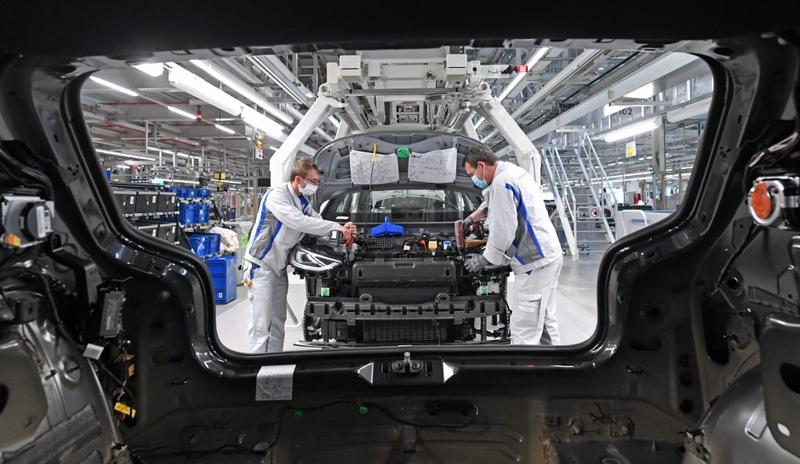 This April 23, 2020, photo shows employees wearing face masks as they work on the assembling of a Volkswagen ID.3 electric car at the plant of German car maker Volkswagen (VW) in Zwickau, eastern Germany. (HENDRIK SCHMIDT / POOL / AFP)
This April 23, 2020, photo shows employees wearing face masks as they work on the assembling of a Volkswagen ID.3 electric car at the plant of German car maker Volkswagen (VW) in Zwickau, eastern Germany. (HENDRIK SCHMIDT / POOL / AFP)
BERLIN - The German economy contracted at its steepest rate on record in the second quarter as consumer spending, company investment and exports all collapsed during the peak of the COVID-19 pandemic, wiping out nearly 10 years of growth.
The number of people out of work fell by 18,000 to 2.923 million people in seasonally adjusted terms, leaving the joblessness rate at 6.4%
The Federal Statistics Office said gross domestic output in Europe’s largest economy shrank by 10.1 percent quarter-on-quarter from April to June after a revised 2.0 percent contraction in the first three months of the year.
The plunge was the steepest since the office began collecting quarterly growth data in 1970 and was worse than the 9 percent contraction predicted by economists in a Reuters poll. Adjusted for inflation, seasonal and calendar effects, it erased almost a decade of growth, the statistics office said.
ALSO READ: Germany plunges into recession with biggest slump in decade
“Now it’s official, it’s the recession of a century,” said DekaBank economist Andreas Scheuerle.
“What has so far been impossible to achieve with stock market crashes or oil price shocks was achieved by a 160 nanometre tiny creature named coronavirus."
On the year, gross domestic product declined by 11.7 percent from April to June, seasonally adjusted figures showed. Analysts polled by Reuters had expected a 11.3 percent contraction.
Both exports and imports of goods and services collapsed in the second quarter, as did household spending and investment in equipment, the office said. But state spending increased.
Commerzbank chief economist Joerg Kraemer said the recovery already started at the end of April, meaning that a strong increase in output was on the cards for the third quarter.
“However, this does not change the fact that it will take the German economy a long time to return to its pre-crisis level,” Kraemer added.
Unexpected fall in unemployment
Giving a rare ray of light for the economic outlook, unemployment unexpectedly declined in July, separate data from the Labour Office showed on Thursday.
The number of people out of work fell by 18,000 to 2.923 million people in seasonally adjusted terms, leaving the joblessness rate at 6.4 percent.
A Reuters poll had forecast an increase of 43,000, which would have pushed the unemployment rate to 6.5 percent.
“The job market is still under pressure due to the coronavirus pandemic, even though the German economy is on a recovery course,” Daniel Terzenbach from the Labour Office said.
He added that the massive use of short-time work had helped to prevent higher unemployment and job losses.
Short-time work is a form of state aid designed to encourage companies to keep employees on the payroll during a downturn. It allows employers to switch employees to shorter working hours and is intended to stop shocks such as the coronavirus crisis from leading into mass unemployment.
The joblessness data boosted hopes that the labour market could get out of the crisis with no more than a black eye, which could support household spending.
READ MORE: France, Germany propose 500 billion euro EU Recovery Fund
The government hopes its stimulus package — worth more than 130 billion euro (US$153 billion), including a temporary VAT cut to boost domestic demand — will help the economy return to growth.
Overall, the government expects the economy to shrink by 6.3 percent this year and rebound with an expansion of 5.2 percent in 2021. This means that the German economy is unlikely to reach its pre-crisis level before 2022.


